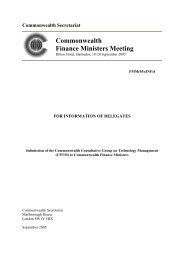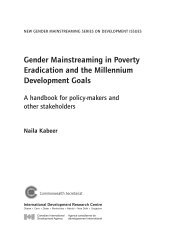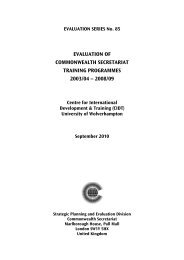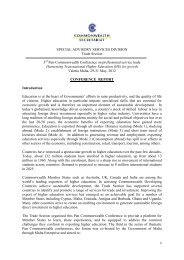Gender Mainstreaming in HIV/AIDS - Commonwealth Secretariat
Gender Mainstreaming in HIV/AIDS - Commonwealth Secretariat
Gender Mainstreaming in HIV/AIDS - Commonwealth Secretariat
You also want an ePaper? Increase the reach of your titles
YUMPU automatically turns print PDFs into web optimized ePapers that Google loves.
GENDER MAINST R E A M I NG IN <strong>HIV</strong>/<strong>AIDS</strong>: TA K I NG A MULT I S E C TORAL APPROACH<br />
Adolescent girls <strong>in</strong> a slum<br />
<strong>in</strong> Mumbai, India, listen to<br />
a woman discuss ways to<br />
refuse unwanted sexual<br />
advances as part of a local<br />
<strong>in</strong>itiative for girls who are<br />
not enrolled <strong>in</strong> school.<br />
UNICEF/HQ00-0111/<br />
Alexia Lewnes<br />
will not treat them with respect (<strong>Commonwealth</strong> <strong>Secretariat</strong><br />
and Healthl<strong>in</strong>k Worldwide, 2001).<br />
An estimated 13.2 million children have been orphaned by<br />
<strong>AIDS</strong> worldwide s<strong>in</strong>ce the beg<strong>in</strong>n<strong>in</strong>g of the epidemic. As well<br />
as possibly be<strong>in</strong>g <strong>in</strong>fected themselves, they face greater risks of<br />
malnutrition, illness, abuse and sexual exploitation than children<br />
orphaned by other causes (UN<strong>AIDS</strong>, 2001b). Marg<strong>in</strong>alised<br />
young people (<strong>in</strong>clud<strong>in</strong>g street children, refugees and<br />
migrants) may also be at particular risk because of stigma, their<br />
exposure to unprotected sex (<strong>in</strong> exchange for food, protection<br />
or money) and the use of illegal drugs (UNDPI and UN<strong>AIDS</strong>,<br />
2001). Inject<strong>in</strong>g drug use is ris<strong>in</strong>g <strong>in</strong> young people <strong>in</strong> some<br />
countries, <strong>in</strong>creas<strong>in</strong>g the risk of <strong>HIV</strong> transmission through<br />
shar<strong>in</strong>g contam<strong>in</strong>ated needles and syr<strong>in</strong>ges (<strong>Commonwealth</strong><br />
<strong>Secretariat</strong> and Healthl<strong>in</strong>k Worldwide, 2001).<br />
Young women often have less decision-mak<strong>in</strong>g power regard<strong>in</strong>g<br />
sexuality than adult women, especially because they tend<br />
to have older male partners. These men may be better off and<br />
able to provide the women with th<strong>in</strong>gs that they cannot otherwise<br />
afford: clothes, cosmetics and even school fees. The relationship<br />
may be encouraged by parents <strong>in</strong> some <strong>in</strong>stances<br />
because of f<strong>in</strong>ancial benefits for the family. These older partners<br />
can dom<strong>in</strong>ate the young women because of their age and<br />
gender, and may have had many previous partners and be<br />
<strong>in</strong>fected with STIs. Sometimes they actively seek out young<br />
girls because they hold the erroneous belief that sex with a<br />
v i rg<strong>in</strong> can cure a man of <strong>in</strong>fection. Girls also marry at an earlier<br />
age than boys.<br />
Young women who show knowledge about sex and reproduction<br />
may be seen as promiscuous and risk gett<strong>in</strong>g a “tarnished<br />
sexual reputation” (Kumar, Lark<strong>in</strong> and Mitchell, 2001).<br />
For many young women, discussion around the subject of sex is<br />
limited to warn<strong>in</strong>gs about its dangers and about the importance<br />
of preserv<strong>in</strong>g their ‘honour’ (Rivers and Aggleton,<br />
1999a). Their parents may strictly control their possibilities of<br />
access<strong>in</strong>g services such as contraceptives and condoms (De<br />
Bruyn, 2000). Young women are also often expected to be<br />
passive, which leaves them with little control over when,<br />
where and how sexual activities occur, <strong>in</strong>clud<strong>in</strong>g the use of<br />
condoms (UN<strong>AIDS</strong>, 2001a).<br />
Biologically, young women are particularly vulnerable<br />
because their immature genital tracts may tear dur<strong>in</strong>g sexual<br />
activity, creat<strong>in</strong>g a greater risk of <strong>HIV</strong> transmission. This is<br />
especially likely dur<strong>in</strong>g forced sex. Social expectations may<br />
also lead adolescent girls to engage <strong>in</strong> anal sex to preserve their<br />
virg<strong>in</strong>ity.<br />
Like young women, young men are <strong>in</strong> the phase of establish<strong>in</strong>g<br />
their sexual and gender identities, and face various pressures<br />
regard<strong>in</strong>g the exercise of their sexuality not only from society<br />
at large (parents, religion, the media) but also from their peers<br />
(De Bruyn, 2000). Unlike young women, however, young men,<br />
are expected to be sexually knowledgeable, which may deter<br />
them from seek<strong>in</strong>g <strong>in</strong>formation for fear of appear<strong>in</strong>g ignorant.<br />
They are also expected to be aggressive and <strong>in</strong> control of sexual<br />
relationships. Young men are often encouraged to start<br />
hav<strong>in</strong>g sex from an early age and to have a number of different<br />
partners to prove their manhood. There is a lot of pressure on<br />
them from their friends and society.<br />
In many countries, a number of young men have their first<br />
A GENDER ANA LYSIS OF <strong>HIV</strong>/<strong>AIDS</strong><br />
40 41














